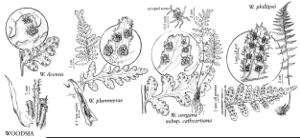Woodsia oregana subsp. cathcartiana
Contr. Univ. Michigan Herb. 19: 58. 1993.
Cells on pinnule margins irregular in shape, margins usually minutely dentate and appearing ragged; adaxial epidermal-cells averaging more than 120 µm. Spores averaging 45–50 µm. 2n = 152.
Phenology: Sporulating summer–fall.
Habitat: Cliffs and rocky slopes, found on a variety of substrates including both granite and limestone
Elevation: 0–4000 m
Distribution

Man., Ont., Que., Sask., Ariz., Calif., Colo., Idaho, Iowa, Kans., Mich., Minn., Mont., Nebr., Nev., N.Mex., N.Y., N.Dak., Okla., S.Dak., Utah, Wis., Wyo.
Discussion
D. F. M. Brown (1964) believed that Woodsia oregana subsp. cathcartiana was confined to a single locality on the Minnesota-Wisconsin border. Recent chromosome counts, however, indicate that the tetraploid cytotype of Woodsia oregana is actually more widespread than the diploid subsp. oregana (M. D. Windham 1993). The inclusion of western U.S. collections within the definition of this taxon is supported by isozyme data that indicate some plants from Arizona and New Mexico are identical to those collected at the type locality of subsp. cathcartiana. In addition to crossing with subsp. oregana (see comments above), W. oregana subsp. cathcartiana hybridizes with W. neomexicana to produce sterile tetraploids of intermediate morphology. It also crosses with W. obtusa subsp. obtusa, resulting in the sterile tetraploid W. × kansana Brooks. F. S. Wagner (1987) has shown that W. oregana subsp. cathcartiana, not W. scopulina, hybridizes with W. ilvensis to form the sterile triploid W. × abbeae. Some morphologic evidence suggests that W. × maxonii may be a hybrid between subsp. cathcartiana and W. scopulina subsp. laurentiana; this hypothesis requires further testing. The difficulties involved with separating subsp. cathcartiana from certain plants of W. plummerae are discussed under that species.
Selected References
None.
Lower Taxa
"/5lengthofblade" is not declared as a valid unit of measurement for this property."thin" is not a number.
